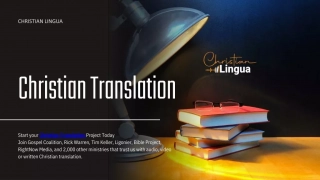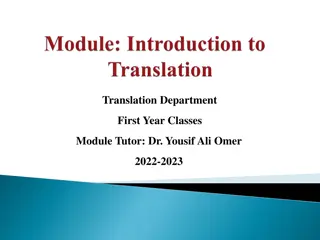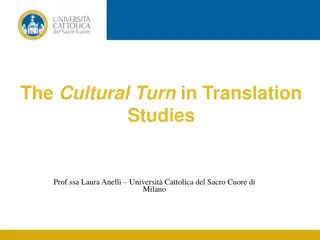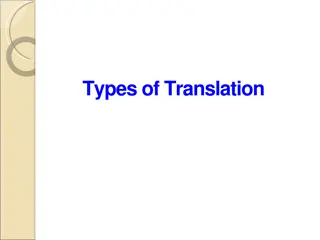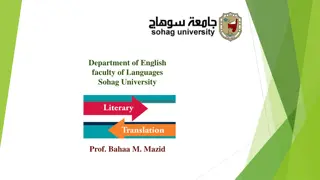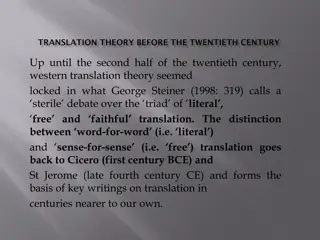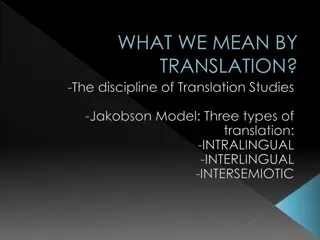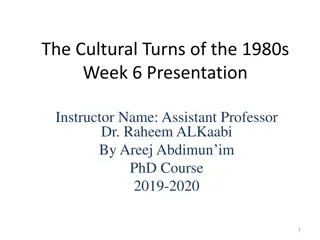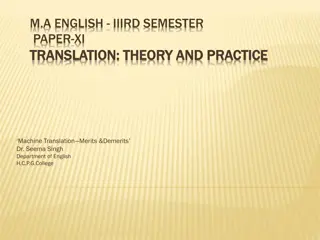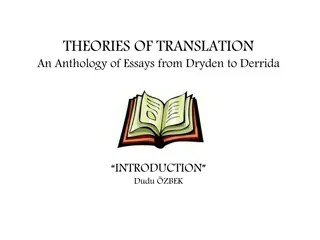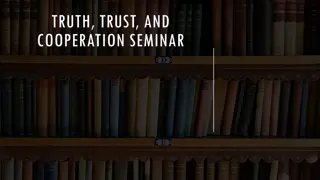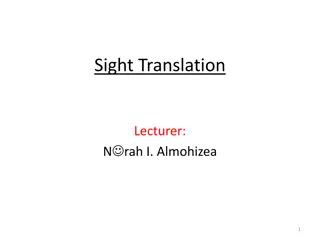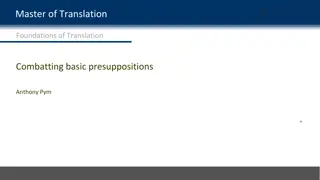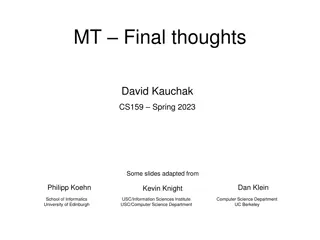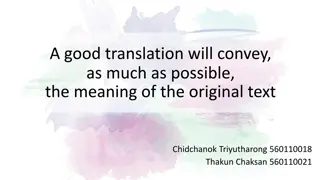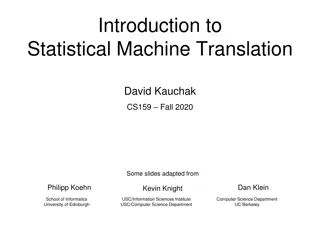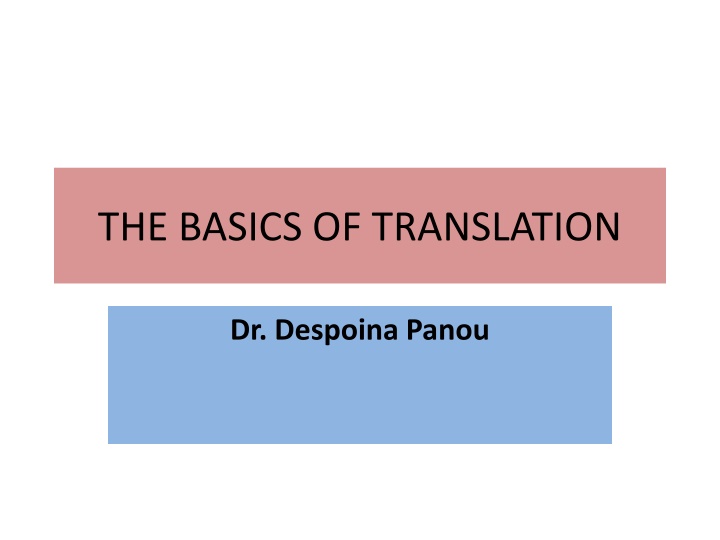
Basics of Translation: Understanding the Key Concepts and Principles
Explore the fundamentals of translation, including the definition, elements, concepts, and the role of translation as a form of mediation. Learn about the importance of meaning, style, context, and structure in the translation process.
Download Presentation

Please find below an Image/Link to download the presentation.
The content on the website is provided AS IS for your information and personal use only. It may not be sold, licensed, or shared on other websites without obtaining consent from the author. If you encounter any issues during the download, it is possible that the publisher has removed the file from their server.
You are allowed to download the files provided on this website for personal or commercial use, subject to the condition that they are used lawfully. All files are the property of their respective owners.
The content on the website is provided AS IS for your information and personal use only. It may not be sold, licensed, or shared on other websites without obtaining consent from the author.
E N D
Presentation Transcript
THE BASICS OF TRANSLATION Dr. Despoina Panou
What is translation? Translation is the replacement of textual material from the source language (SL) by equivalent textual material in another language (TL) (Catford, 1969:20). Translation consists in reproducing in the receptor language the closest natural equivalent of the source language message, first in terms of meaning and secondly in terms of style (Nida, 1969:12). Translation is a craft consisting in the attempt to replace a written message and/ or statement in one language by the same message and/or statement in another language (Newmark, 1981: 7). Translation is s process of finding a TL equivalent for an SL utterance (Pinchuck, 1977:38). In short terms, translation can be defined as transferring a message from the source language into the target language by expressing its meaning and the style of language.
Elements of translation Elements of Translation Source Language Meaning/Message /Style Target Language
CONCEPTS IN TRANSLATION It can be concluded that translation indicates: Two languages: source language (SL) and target language (TL) or receptor language (RL). Reproducing the meaning, message, statement, utterance, style of the SL text into that of the TL text. There are many concepts of translation, such as reproduce, replace, render, but one thing is certain that translation is an act of recreating meaning, not creating meaning.
TEXT TRANSLATION Unity: meaning, context. Meaning content, idiomatic expression. Style: Scientific, Formal, Informal, Informal Short story, drama, poetry, literary work, ancient words, informal, slang. Structure and Grammar (words, phrases, clauses, text, discourse) Translator must know structuring rules general idea, wording, coherence, and vocabulary, register, cultural
TRANSLATION AS MEDIATION(1) On the face of it, the task in translation is to rework a text written in one language into another so as to make available to a new audience something they would not otherwise be able to access. This means that a translator is involved in communicating meanings that have been constructed in one language with its accompanying cultural contexts for readers who share the language and participate in some way in that culture to an audience that does not share that language and culture. (Translation as intercultural mediation: setting the scene Anthony J. Liddicoat in Perspectives 2016, 24 (3), 347-353.
TRANSLATION AS MEDIATION (2) Hence translation cannot entail simply reproducing the meanings of one text in another language; rather, after constructing a reading of the text and its intention, the translator must rearticulate meanings for new audiences. Through the medium of the translator's voice, multiple linguistic and cultural framings are brought into relation so that meanings may be communicated across linguistic and cultural boundaries. (Translation as intercultural mediation: setting the scene Anthony J. Liddicoat in Perspectives 2016, 24 (3), 347-353.
TRANSLATION AS MEDIATION (3) As the agent of communication across linguistic and cultural boundaries, the translator is in a mediating position between the writer and reader and also between the cultures of composition and reception. This view of translator as mediator is far from new. For example, in the 1960s Kade (1968) used the idea of linguistic mediation (Sprachmittlung) as a way of conceptualising the field of translating and interpreting studies. Thus, translation has been understood as a form of mediational work involving a positioning of the translator between two interlocutors who are speakers of different languages and acting to achieve communication where otherwise there would be no shared language. (Translation as intercultural mediation: setting the scene Anthony J. Liddicoat in Perspectives 2016, 24 (3), 347-353.
TRANSLATION AS MEDIATION (4) The translator as a linguistic intermediary can be understood in a number of ways. At a superficial level, the mediator can be seen as simply the channel through which communication is established; that is, mediation is little more than a description of the role of the translator and identifying translators as mediators brings little additional understanding to translators work. (Translation as intercultural mediation: setting the scene Anthony J. Liddicoat in Perspectives 2016, 24 (3), 347-353.
TRANSLATION AS MEDIATION (5) Alternatively, the mediator can be understood as someone who undertakes some form of action to enable communication to occur; that is, the translator as mediator is an agent of intercultural communication and mediation is seen as a conscious, purposeful intervention into the act of communication. Understood in this way, the idea of mediation frames the act of translation as a complex engagement with meanings across languages and cultures (see Katan, 2013 for a discussion of these two ways of understanding mediation).
AN EXAMPLE TRANSLATION OF NEWSPAPER HEADLINES The below heading of a medical article indicates a tendency for more information: ST118 Turning the screw some more (heading) ( Turning the screw some more , The Economist, 24.11.2009) TT118 . ( . , , 29.11.2009) BT118 AIDS has startedto retreat.Antiviral drugs have become more accessible. More specifically, the translator has used the strategy of transediting and has provided the Greek target readership with an alternative heading based on the translator s interpretation of the text that follows. In more detail,AIDS is the central topic of the article in question and it is asserted that considerable progress is being made in the fight against AIDS since thedeath rate is falling and anti-viral drugs have become more accessible. Since this is a rather optimistic message, the translator decides to use it as a heading in order to attract the readers attention. This two-sentence heading is indicative of the translator s choice to elaborate and give their target readership more information. In this instance, Sidiropoulou s claim (1995:298) that the Greek version of medical headlines requires less information is challenged.
TRANSLATION THEORY What translation theory actually does is to identify and define a translation problem; to indicate all the factors that have to be taken into account in solving the problem, to list all the possible translation procedures, and finally, to recommend the most suitable translation procedure, plus the appropriate translation. This is why translation is a decision-making process and a problem-solving task: Decision-making, because of the choices the translator faces. As Hatim & Mason (1990:12) say, translation is a matter of choice, but choice is always motivated: omissions, additions and alterations may indeed be justified but only in relation to intended meaning. Problem-solving, as the translator is always trying to solve a thousand small problems in the context of a large one (Newmark, 1988:8). (Translation-Strategies Use: A Classroom-Based Examination of Baker s Taxonomy. [accessed Oct 20 2023].
STRATEGIES VS. PROCEDURES Strategies have been viewed as solutions to a problem (Chesterman, 1997, 89) whereas procedure has a more concrete orientation since it refers to a specific technique. As Munday (2012) puts it: a strategy is the overall orientation of a translated text while a procedure is a specific technique used at a given point in a text (2012, 22).
Translation Strategies There are five major translation tendencies underlying the translation of a linguistic category (e.g.names) namely: 1) preservation, 2) modification, 3) expansion, 4) omission 5) creation.
Bakers (1992) taxonomy of translation strategies (1) Translation by a more general word This is one of the most common strategies to deal with many types of non- equivalence. As Baker believes, it works appropriately in most, if not all, languages, because in the semantic field, meaning is not language dependent. Translation by a more neutral/ less expressive word. This is another strategy in the semantic field of structure. Translation by cultural substitution This strategy involves replacing a culture-specific item or expression with a target language item considering its impact on the target reader. This strategy makes the translated text more natural, more understandable and more familiar to the target reader. The translator's decision to use this strategy will depend on: The degree to which the translator is given license by those who commission the translation The purpose of the translation (Baker s Strategies in Translation: A Lexico-Semantic Analysis of Four Luhya Dialects; Lukabras, Lwisukha, Luwanga and Lukhayo in Informative Text, September 2019, Mudogo Benard)
Bakers (1992) taxonomy of translation strategies (2) Translation using a loan word or loan word plus explanation This strategy is usually used in dealing with culture-specific items, modern concepts, and buzz words (e.g. influencer). Using the loan word with an explanation is very useful when a word is repeated several times in the text. At the first time the word is mentioned by the explanation and in the next times the word can be used by its own. Translation by paraphrase using a related word This strategy is used when the source item in lexicalized in the target language but in a different form, and when the frequency with which a certain form is used in the source text is obviously higher than it would be natural in the target language. (Baker s Strategies in Translation: A Lexico-Semantic Analysis of Four Luhya Dialects; Lukabras, Lwisukha, Luwanga and Lukhayo in Informative Text, September 2019, Mudogo Benard)
Bakers (1992) taxonomy of translation strategies (3) Translation by paraphrase using unrelated words The paraphrase strategy can be used when the concept in the source item is not lexicalized in the target language. When the meaning of the source item is complex in the target language, the paraphrase strategy may be used instead of using related words; it may be based on modifying a super-ordinate or simply on making clear the meaning of the source item. Translation by omission This may be a drastic kind of strategy, but in fact it may be even useful to omit translating a word or expression in some contexts. If the meaning conveyed by a particular item or expression is not necessary to mention in the understanding of the translation, translators use this strategy to avoid lengthy explanations. Translation by illustration This strategy can be useful when the target equivalent item does not cover some aspects of the source item and the equivalent item refers to a physical entity which can be illustrated, particularly in order to avoid over-explanation and to be concise and to the point. (Baker s Strategies in Translation: A Lexico-Semantic Analysis of Four Luhya Dialects; Lukabras, Lwisukha, Luwanga and Lukhayo in Informative Text, September 2019, Mudogo Benard)
CONCLUSION TRANSLATION IS NEVER A STRAIGHTFORWARD ACTIVITY (Maria Sidiropoulou)

